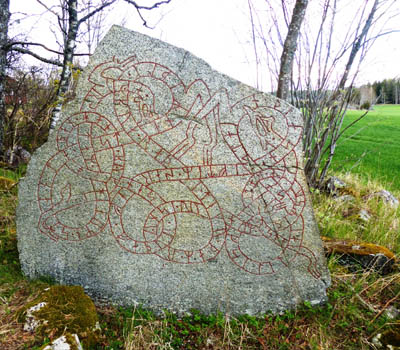Runic writing in the Germanic languages (RuneS)
Links to the project
The research project “Runische Schriftlichkeit in den germanischen Sprachen / Runic Writing in the Germanic Languages (RuneS)” investigates the oldest writing system in the Germanic languages, the runic script. As a means of communication this script was used in different variants in large regions of Europe (with centres in what is now Germany and the Netherlands, in Great Britain and Scandinavia) over a period of more than 1,400 years. In these languages, it preceded and for a long period co-existed with Latin literacy. Apart from editorial work, research on runic monuments has hitherto concentrated predominantly on understanding the text of the individual inscriptions and their historico-cultural interpretation. Our project, in contrast, explicitly regards the runic script as a system evolved in various ways over the centuries, serving diverse communicative functions within the different historical societies it was used in.
 Runic writing in the Germanic languages (RuneS)
Runic writing in the Germanic languages (RuneS)Runic writing in the Germanic languages (RuneS)
Host Academy
Göttingen Academy of Sciences and Humanities in Lower Saxony
Location and federal state
Eichstätt, Bavaria; Göttingen, Lower Saxony; Kiel, Schleswig-Holstein
Type
Editions: Philosophy, History of Science, Linguistics and Literary Studies
Project number
II.B.44-1-3
It is the aim of the project to describe and analyse runic writing systematically, supra-regionally and temporally in a comprehensive way. Both aspects of writing, the phonetic-phonological aspect (Graphemics) and the text-pragmatic and functional aspect (Pragmatics) will be investigated. A comprehensive database of the inscriptions from all language areas (Germany, the Netherlands, England, Scandinavia) has been developed as research basis. The findings of the investigations will also reflect on new editions (inscriptions in the Older fuþark, the Pre-Old English and Old English inscriptions, the Pre-Old Frisian and Frisian inscriptions and the so-called Runica Manuscripta). The comprehensive design of the project with regard to time and space makes it possible to focus on the above issues more consistently and to formulate comparative statements on the development of runic writing from a historico-cultural perspective. As runic writing existed alongside Latin literacy over a longer period of time, the question of the influence the Latin script exerted on the creation and development of the runic script is central and possible interdependencies will be highlighted in the course of the project.
Back to overview
